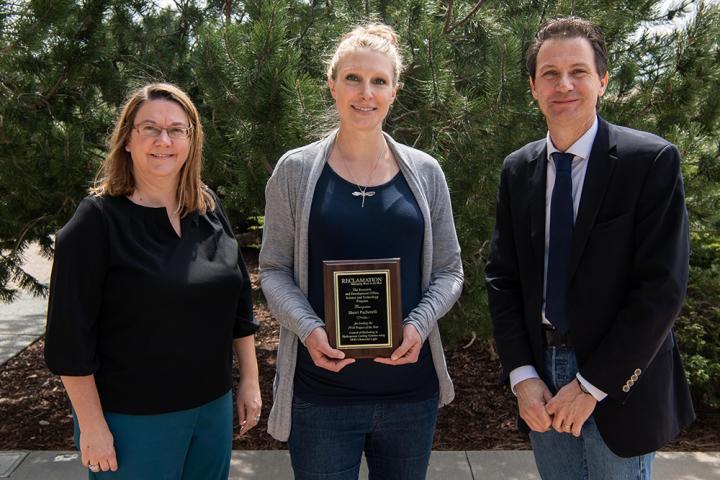System causes delayed mortality of mussel larvae and reduces mussel settlement by 88-99% in hydropower cooling systems

Credit: Alexander Stephens, Bureau of Reclamation
The Bureau of Reclamation’s Science and Technology Program focuses on providing innovative solutions for water and power challenges in the western United States. One research project stood out in 2018 and was recently selected as the Project of the Year. The award was presented to Sherri Pucherelli for the project entitled, “Control of biofouling in hydropower cooling systems using hydro-optic ultraviolet light.” The award was selected for its positive impact to Reclamation, other federal and non-federal partners, its efforts to address the current Department of the Interior priorities, the involvement of partners, and its level of innovation.
Reservoirs along the lower Colorado River are infested with quagga mussels and colonial hydroid. These invasive species, along with native freshwater sponges and bacteria, pose significant biofouling issues for hydropower facilities in the area. Biofouling in the generator cooler systems at Parker Dam, on Lake Havasu, Arizona, has resulted in increased annual maintenance costs of approximately $80,000/year.
Medium pressure, hydro-optic ultraviolet light systems with a 100 mJ/cm2 target dose were installed on four main turbine cooling water lines and a raw water supply for the onsite water treatment facility at Parker Dam to mitigate biofouling. This study was designed to monitor the impact of HOD UV on biofouling over a two-year period. Comparison of biofouling dry weight from settlement plates exposed to HOD UV-treated and untreated water indicate a significant reduction in total biofouling after HOD UV exposure.
Mussel settlement and bacterial sludge formation were consistently reduced in bioboxes despite lower than expected average HOD UV dose and contamination with untreated water. Hydroid settlement reduction data after HOD UV treatment were inconclusive.
The research found that UV treatment causes delayed mortality of mussel larvae and reduces mussel settlement by 88-99% at doses between 20-100 mJ/cm2. Since full-scale implementation at Parker Dam, operators have noticed a significant reduction in cooler overheating and maintenance savings The Parker Dam facility manager confirmed that biofouling-related maintenance of the coolers was reduced by 75% after the first year of HOD UV operation and eliminated in the second and third years after implementation.
“Using existing UV technology for a new application at our facilities will help reduce costs and maintenance effort,” said Pucherelli, lead researcher on the study. “The results of this UV research and previous Science and Technology funded projects has led to the full-scale implementation of UV treatment at Parker and Hoover Dams for the mitigation of mussel settlement and associated costs.”
The study involved several research partners including Reclamation’s Lower Colorado Dams Office, RNT Consulting Inc, and KASF Consulting LLC. In addition to Pucherelli, staff supporting the project included Jacque Keele and Yale Passamaneck, all of Reclamation’s Technical Service Center.
“The Science and Technology Program has been supporting invasive mussel research for many years, including 28 projects in 2019,” Chief of Research and Development Levi Brekke said. “It is exciting to see the results of a research project have real, tangible impacts on Reclamation’s ability to efficiently deliver water and power to communities in the West. These results also help ensure the reliability of our operations to meet our customer demands for water and power.”
Along with the award, Sherri and the team receive up to $10,000 for funding to expand outreach of the project through internal Reclamation presentations in the following fiscal year.
###
To learn more about the Science and Technology Program, please visit https:/
Media Contact
Peter Soeth
[email protected]
Original Source
https:/



